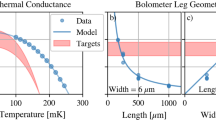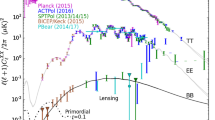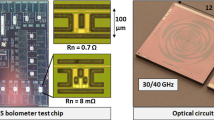Abstract
We are developing multi-chroic antenna-coupled Transition Edge Sensor (TES) bolometer detectors for Cosmic Microwave Background (CMB) polarimetry. Multi-chroic detectors increase focal plane area efficiency, and thus the mapping speed per focal plane area, and provide greater discrimination against polarized galactic foregrounds with no increase in weight or cryogenic cost. In each pixel, a silicon lens-coupled dual-polarized sinuous antenna collects photons over a two-octave frequency band. The antenna couples the broadband millimeter wave signal into microstrip transmission lines, and on-chip filter banks split the broadband signal into multiple frequency bands. Separate TES bolometers detect the power in each frequency band and linear polarization state. We will describe the design and performance of these devices and present optical data taken. Our measurements of dual-polarization pixels in multiple frequency bands show beams with percent-level ellipticity, and percent-level cross-polarization leakage. We will also describe the development of large arrays of these multi-chroic pixels. Finally, we will describe kilo-pixel arrays of these detectors planned for the future CMB experiments that will achieve unprecedented mapping speed.




Similar content being viewed by others
References
K. Arnold, Design and Deployment of the POLARBEAR Cosmic Microwave Background Polarization Experiment. PhD thesis, University of California, Berkeley, 2010
R.H. Duhamel, Dual polarized sinuous antennas, 14 (1987)
J.M. Edwards, R. O’Brient, A.T. Lee, G.M. Rebeiz, Dual-polarized sinuous antennas on extended hemispherical silicon lenses. IEEE Trans. Antennas Propag. 60(9), 4082–4091 (2012)
D. Filipovic, Double-slot antennas on extended hemispherical and elliptical silicon dielectric lenses. IEEE Trans. Microw. Theory Tech. 41(10), 1738–1749 (1993)
C. Galbraith, G. Rebeiz, Higher order cochlea-like channelizing filters. IEEE Trans. Microw. Theory Tech. 56(7), 1675–1683 (2008)
S. Kumar, A. Vayonakis, H. LeDuc, P. Day, S. Golwala, J. Zmuidzinas, Millimeter-wave lumped element superconducting bandpassfilters for multi-color imaging. IEEE Trans. Appl. Supercond. 19(3), 924–929 (2009)
R. O’Brient, A Log Periodic Focal-Plane Architecture for Cosmic Microwave Background Polarimetry. PhD thesis, University of California, Berkeley (2010)
R. O’Brient, P. Ade, K. Arnold, J. Edwards, G. Engargiola et al., A dual-polarized broadband planar antenna and channelizing filter bank for millimeter wavelengths. Appl. Phys. Lett. 102(6), 063506 (2013)
A. Suzuki, K. Arnold, J. Edwards, G. Engargiola, A. Ghribi, et al. Multichroic dual-polarization bolometric detectors for studies of the cosmic microwave background, in Proceedings of Millimeter, Submillimeter, and Far-Infrared Detectors and Instrumentation for Astronomy VI, pp. 84523H–84523H-10, (2012)
Acknowledgments
We acknowledge support from the NASA, NASA grant NNG06GJ08G. Detectors were fabricated at Berkeley nanofabrication laboratory. Praween Siritanasak is supported by the Royal Thai Government fellowship.
Author information
Authors and Affiliations
Corresponding author
Rights and permissions
About this article
Cite this article
Suzuki, A., Arnold, K., Edwards, J. et al. Multi-Chroic Dual-Polarization Bolometric Detectors for Studies of the Cosmic Microwave Background. J Low Temp Phys 176, 650–656 (2014). https://doi.org/10.1007/s10909-013-1049-5
Received:
Accepted:
Published:
Issue Date:
DOI: https://doi.org/10.1007/s10909-013-1049-5




